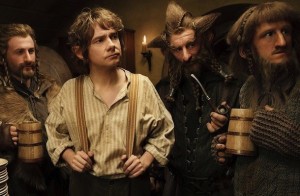The Hobbit: An Unexpected Journey (Jackson, 2012)
 I’ve never been a Peter Jackson fan.
I’ve never been a Peter Jackson fan.
I’ve tried perhaps more than striven to revisit, to cultivate a taste for The Lord of the Rings franchise, mostly for friendship’s sake or with the dull resignation akin to the non-sports fan who finds himself immersed in a local culture rabidly following the beloved team to a championship. When the last of that trilogy took home eleven golden statues, I was almost happy for my friends who enjoyed extended cuts, movie marathons and snarky comments about the Rankin-Bass cartoons that I secretly preferred.
Given that back story, the most surprising part of my Hobbit experience was my complete and utter lack of schadenfreude.
The Hobbit is a dreary affair, made more so by the realization, about ten minutes into the film, that there will be nine more hours over the next three years. Over at The Thin Place podcast, Todd Truffin and I have done the dull but necessary drudge work of itemizing the worst of Jackson’s offenses against J. R. R. Tolkien’s book for those whose cinematic judgments are dependent upon a devotee’s insistence that when it comes to literary adaptations, “getting it right” is a phrase that can have actual meaning, so I won’t repeat the litany here.
Neither will I spend too much time lamenting the seemingly curious decision to use a franchise centerpiece to experiment (unsuccessfully, in my opinion) with projecting at forty-eight frames per second. Audiences may be resigned to pointless 3D in every other movie, but this is an artistic choice that dwarfs every other choice in the film, makes it nearly impossible to think about anything else on a first viewing. Maybe this is what the first audience that saw deep focus struggled with. The art design in the establishing shots looks sublime, but the second anyone moves it is like a painting moving around.
What I will say here is that given yet more set detail, Jackson appears to have yet more indecision about where and for how long to point the camera. If there is a coherent auterish vision for what this material should be and how this story should be told, it was not one that I could deduce. With so many angles, pans, and scene compositions appearing to be made to highlight some aspect of the set or show off some ability of the cinematography rather than tie scenes together with a coherent style.
Some of that stylistic pastiche must surely be the result of the decision to split The Hobbit into three films, necessitating the grafting of material from other sources. The first ten minutes of The Fellowship of the Rings is not only referenced, it is retold. Instead of the back story of the dwarves being parceled out in bits and pieces throughout the journey it is told in one prologue. A council at Rivendell comes across as an excuse to bring back actors from the trilogy rather than a meaningful part of this story.
No individual directorial or artistic decision in the nearly three hours is indefensible–okay, except maybe one involving a change in how Bilbo comes to find the Ring of Doom–but they all seem so random, so haphazard, as though each one were made in a vacuum and without consideration of any other one. Parts are camp comedy, parts CGI sword slashing, parts solemn intonations about fate and when not to kill. The closest the film has to a core is either the relationship between Bilbo and Thorin Oakenshield or the decision to present the the film as a diaspora story. The latter not only turns a children’s adventure story into a socio-political allegory but it completely fails to fathom why the book is called The Hobbit rather than, say, The Politics of Middle Earth, Volume 5: Dwarves–Allegory for Israelites or Palestinians?

